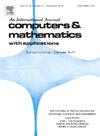In-plane vibration analysis of elastically restrained FGM skew plates using variational differential quadrature method
IF 2.9
2区 数学
Q1 MATHEMATICS, APPLIED
引用次数: 0
Abstract
This work presents an accurate in-plane vibration analysis of functionally graded material (FGM) skew plates with elastically restrained boundaries using the variational differential quadrature method (VDQM). The weak form of the governing equations is derived by integrating two-dimensional elasticity theory with Hamilton's principle. The differential and integral operators are directly converted into matrix forms, thereby removing the necessity for higher-order derivative approximations in the displacement field. Transformation matrices are then developed for both interior and boundary nodes to link the governing equations with the boundary conditions, leading to the formulation of the vibration eigenvalue equations for FGM skew plates. Various factors, including aspect ratios, skew angles, boundary restraints, and gradient indices, are considered to investigate the in-plane vibration mode characteristics of FGM skew plates. Detailed solution procedures are provided, and numerical examples using the proposed solutions indicate that the VDQM exhibits superior numerical convergence and stability compared to other existing methods. The study also investigates the influence of highly skewed plates (75°), where stress singularities arise at the corners. This aspect is crucial for in-plane vibration analysis and has garnered limited attention in the existing literature. Furthermore, the dynamic analysis of FGM skew plates reveals a coupling between normal and tangential vibration modes.
变分微分正交法分析弹性约束FGM斜板的面内振动
本文利用变分微分正交法(VDQM)对具有弹性约束边界的功能梯度材料(FGM)斜板进行了精确的面内振动分析。将二维弹性理论与哈密顿原理相结合,导出了控制方程的弱形式。微分和积分算子直接转换为矩阵形式,从而消除了位移场中高阶导数近似的必要性。然后建立了内部节点和边界节点的变换矩阵,将控制方程与边界条件联系起来,从而形成了FGM斜板的振动特征值方程。考虑了宽高比、斜角、边界约束和梯度指数等因素,研究了FGM斜板的面内振动模态特征。给出了详细的求解步骤,并通过数值算例表明,该方法具有较好的数值收敛性和稳定性。该研究还研究了高弯曲板(75°)的影响,其中应力奇点出现在角落。这方面对面内振动分析至关重要,但在现有文献中得到的关注有限。此外,FGM斜板的动力分析揭示了法向和切向振动模式之间的耦合。
本文章由计算机程序翻译,如有差异,请以英文原文为准。
求助全文
约1分钟内获得全文
求助全文
来源期刊

Computers & Mathematics with Applications
工程技术-计算机:跨学科应用
CiteScore
5.10
自引率
10.30%
发文量
396
审稿时长
9.9 weeks
期刊介绍:
Computers & Mathematics with Applications provides a medium of exchange for those engaged in fields contributing to building successful simulations for science and engineering using Partial Differential Equations (PDEs).
 求助内容:
求助内容: 应助结果提醒方式:
应助结果提醒方式:


